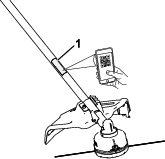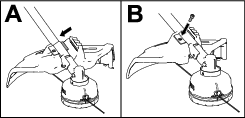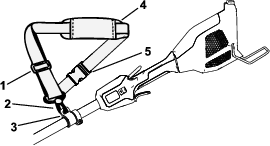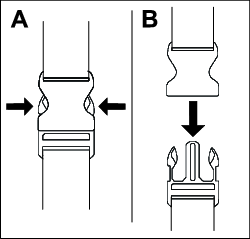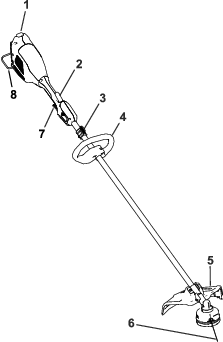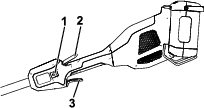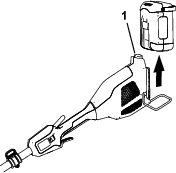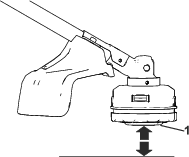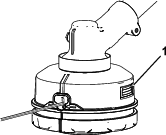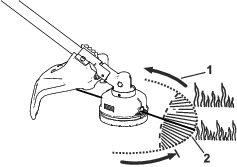Maintenance
After each use of the trimmer, complete the following:
-
Remove the battery pack from the trimmer.
-
Wipe the trimmer clean with a damp cloth. Do not hose the trimmer down or submerge it in water.
Caution
The line cutoff blade on the deflector is sharp and can cut you.
Do not use your hands to clean the deflector shield and blade.
-
Wipe or scrape clean the cutting head area any time there is an accumulation of debris.
-
Inspect the machine, check and tighten all fasteners. If any part is damaged or lost, repair or replace it.
-
Brush debris away from air intake vents and exhaust on motor housing to prevent the motor from overheating.
Replacing the Line
Use only 2.4 mm (0.095 inch) diameter monofilament line.
-
Remove the battery pack.
-
Remove any existing line on the spool by repetitively pressing the bump head while pulling the line out equally from both sides of the bump head.
-
Using 2.4 mm (0.095 inch) line, cut a piece of line that is no longer than 7.3 m (24 ft).
Important: Do not overload the spool.
Important: Do not use any other gauge or type of line, as this could damage the trimmer.
-
Press and turn the bottom of the trimmer head in the direction shown by the arrows (clockwise) on the bottom of the bump head until the bottom green marks align with the green marks beneath the eyelets (Figure 14).
-
Insert 1 end of the line straight into the eyelet and push the line through until it comes out through the eyelet on the other side.
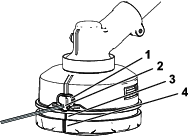
Important: Do not disassemble the trimmer head.
-
Pull the line through the eyelets until there is an equal length of line on each side of the trimmer head.
-
Hold the string trimmer in place with one hand. With your other hand, turn the bottom of the trimmer head in the direction shown by the arrows (clockwise) on the bottom of the bump head to wind the line; leave about 152 mm (6 inches) extending beyond the eyelet on each side.
Replacing the Trimmer Head
-
Remove the battery pack from the trimmer.
-
Align the hole in the cup plate with the hole in the trimmer gearcase (Figure 15).
-
Insert the included metal rod through the cup plate and into the hole in the trimmer gearcase to secure the trimmer head (Figure 15).

-
With the metal rod securing the trimmer head, rotate the trimmer head clockwise to remove it from the threaded gearcase post (Figure 16).
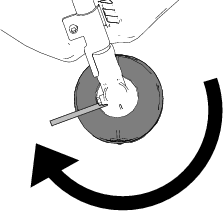
-
To install the new trimmer head, rotate it counterclockwise onto the gearcase post while securing the cup plate using the metal rod.
Lubricating the Gearbox
| Maintenance Service Interval | Maintenance Procedure |
|---|
-
Shut off the trimmer, remove the battery pack, and clean any debris from the trimmer head.
-
Set the trimmer so the gearbox is upright.
-
Remove the plug from the side of the trimmer (Figure 16).
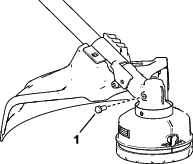
-
Apply a small amount of grease into the gearbox using a grease gun.
Note: Use No. 2 lithium grease.
-
Install the gearbox plug.
Storage
Important: Store the tool, battery pack, and charger only in temperatures that are within the appropriate range; refer to Specifications.
Important: If you are storing the battery pack for the off-season, charge it until 1 or 2 LED indicators turn green on the battery. Do not store a fully charged or fully depleted battery. When you are ready to use the tool again, charge the battery pack until the left indicator light turns green on the charger or all 4 LED indicators turn green on the battery.
-
Disconnect the product from the power supply (i.e., remove the plug from the power supply or the battery pack) and check for damage after use.
-
Do not store the tool with the battery pack installed.
-
Clean all foreign material from the product.
-
When not in use, store the tool, battery pack, and battery charger out of the reach of children.
-
Keep the tool, battery pack, and battery charger away from corrosive agents, such as garden chemicals and de-icing salts.
-
To reduce the risk of serious personal injury, do not store the battery pack outside or in vehicles.
-
Store the tool, battery pack, and battery charger in an enclosed clean, dry area.
